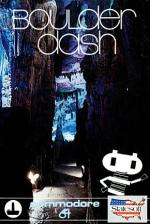Other Reviews Of Boulder Dash For The Commodore 64
Boulder Dash
A review by Sandra Grandison (Personal Computer News)
Boulderdash (Statesoft)
A review
Boulder Dash (First Star)
Apparently, diamonds are a girl's best friend. And they can be found hidden amongst boulders. Eager for some beaver, Rockford is on a mission to find as many as he can on the Commodore 64.


 1st December 1984
1st December 1984













